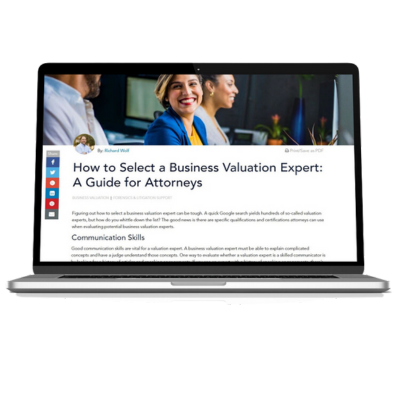A reliable valuation is critical in many different contexts, including private sales, divorce, litigation and estate planning — just to name a few. A frequent challenge in valuing privately-owned businesses involves the treatment of non-operating assets and non-operating liabilities.
Attorneys will benefit from having a basic understanding of these nuances of valuation, as they can have a significant impact on the conclusion of value. Let’s look at how the treatment of non-operating assets and non-operating liabilities can impact the value of a company.
What Are Non-Operating Assets and Non-Operating Liabilities?
Frequently when valuing private companies, valuators come across non-operating assets and liabilities. According to the International Glossary of Business Valuation Terms, the definition of a non-operating asset is an asset that is “not necessary to ongoing operations of the business enterprise.” The same definition can be applied to non-operating liabilities.
A non-operating asset is one that can be sold or distributed to shareholders without impacting the ongoing operations of the business. For example, a vacation condo in Ocean City, Maryland owned by ABC Manufacturing, a manufacturer located in Columbia, Maryland. A non-operating liability is an amount owed by the business enterprise that is not related to the ongoing operations. In this example, a non-operating liability may be the mortgage that ABC Manufacturing has on the condo.
Other examples of non-operating assets could include:
-
Excess cash or excess working capital
-
Marketable securities such as stocks or mutual funds
-
Real estate
-
Personal property unrelated to business activities (boats, RVs, etc.)
-
Loans receivable from company owners
-
Ownership interests in other companies unrelated to the principal business
How Does a Valuator Assess Non-Operating Assets and Non-Operating Liabilities?
When examining excess cash or excess working capital, a valuator will typically compare the subject company to other companies in the same industry. If other companies can effectively operate with a certain level of cash and/or working capital, and the subject company’s cash/working capital is considerably higher, it might necessitate an adjustment. With the significant amount of COVID-19 relief funds that have been made available, we’re seeing many businesses with large cash reserves on hand that require adjustment in the valuation process.
Another form of non-operating assets (or liabilities) can be shareholder receivables or loans. For many privately-owned businesses, owners fund operations through shareholder loans. These transactions are typically viewed as “equity” transactions from a valuation perspective and are thus excluded from the operating value of a business.
Once non-operating assets and/or non-operating liabilities have been identified, what should a valuator do with these items? Once we remove any assets and liabilities from the balance sheet, along with any income and expense items that relate to these non-operating assets and liabilities, we can value the operations of the company as a standalone business. However, because these non-operating assets and/or liabilities are “owned” by the business and should still be included in the overall value, we may then need to add them back to determine the overall value of the company.
Another type of non-operating assets that we encounter is real estate that is owned by the business but does not necessarily have to be part of the business. For example, XYZ Restaurant operates a restaurant and also owns the real estate that XYZ operates out of. In this type of situation, XYZ Restaurant does not need to own the real estate. A valuator may choose to treat the real estate as a non-operating asset (with any mortgage treated as a non-operating liability) and utilize a fair rent when normalizing the income statement. The real estate would then be valued separately and added back to the value of the operating entity.
Treatment of Non-Operating Assets and Liabilities In Divorce
For divorce purposes, non-operating assets and liabilities need to be properly identified and classified. If a business owns a vacation condo, but the corresponding debt is owed by the marital entity, it is critical that the asset and liability are included as part of the marital estate. Similarly, if a company has a shareholder receivable (non-operating asset), there needs to be an expectation of repayment by the shareholder in order for that asset to have value. That debt would need to be included in the shareholder’s marital balance sheet.
Need Help?
Valuators, along with the attorneys they assist, should understand the treatment of non-operating assets and non-operating liabilities in a private company because they can have a significant impact on the conclusion of value. That’s why you’ll want to select a business valuation expert who understands the nuances of non-operating assets and non-operating liabilities, and much more.
Our team of valuation experts is here to help. Contact us online or call 800.899.4623.


